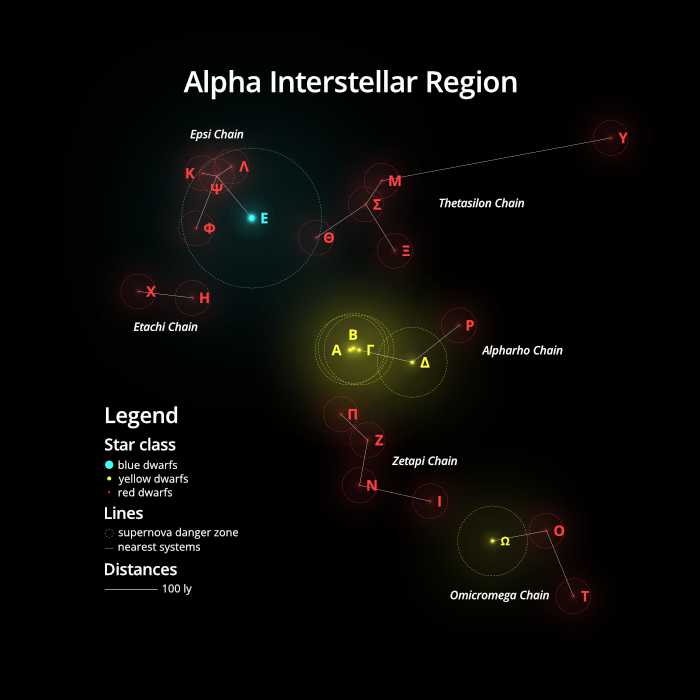← news
Worldbuilding
April 26, 2024

Diagram of the Alpha Interstellar Region, Absurd Realms starts off in the Alpha System (Α)
As my fiction has evolved, so has the complexity of its universe. Until “Exodus,” I could manage all the story details in my confining brain. Now, there are too many to keep track of in there.
Writing “Exodus” has required me to engage in heavy-duty worldbuilding, where I’ve had to explore various software to aid me in this task. Initially, I thought I could rely solely on developing the compendium. While it is suitable for reading, it lacks for use in development.
Finding the least worst options
Frankly, finding the right worldbuilding software has been a journey of trial and error. There is no complete suite that perfectly fits my needs. I’ve explored virtually all the well-known (e.g. World Anvil, LegendKeeper, Fantasia Archive) and less well-known (e.g. Lore Forge, kanka.io, Fortelling) software. I’ve even ventured into software not necessarily intended for worldbuilding (e.g. Google Sheets, Google Docs, Obsidian, Notion).
My extensive search has landed me on using Aeon Timeline for its custom calendar feature, automatic date calculation, and custom data types. While still imperfect, it serves most of my needs beyond the compendium.
For maps and diagrams, I use Affinity Designer (I created the image above using it). This software handles many objects with good performance, which is very useful for my more intricate maps (I consider the diagram above simplistic). In the past, I’ve used tools like Azgaar’s Fantasy Map Generator. However, it suffers relatively low performance when dealing with higher detail (I’d still recommend it if you like generators). I’ve grown more confident in cartography and do not feel an automated solution is necessary for me anyway.
Grounding the universe
Worldbuilding is important because it provides a base from which I can ground the universe. Absurd Realms is science fantasy, so while I do incorporate elements from our real world, I intently depart from reality by creating my own rules.
The above diagram of the Alpha Interstellar Region illustrates this. Red and yellow dwarfs (and “blue dwarfs”) exist in reality, but I do not base their inclusion in Absurd Realms in hard science. The names of the systems of the Alpha Region use the Greek alphabet. While neither Greece nor Greek exists in Absurd Realms (i.e. no real-world culture exists in my fiction), the English language commonly incorporates the Greek alphabet in numbering and classification. I also keep names in my fiction grounded in English words (e.g., calling someone “Fog Eyes”) to make future translations easier.
Even though I enjoyed using Vulgarlang to generate fictional languages, I prefer sticking to English to avoid confusing readers with etymology. Sometimes, I may also use Latin, as many English speakers use Latin phrases or words (modern English is a blend of many languages). Sticking to English also helps with pronunciation, although I recognize this is largely unimportant right now. You may notice the connected subregions in the diagram above (e.g. Alpharho) are a blend of existing words (Alpharho deriving from Greek “alpha” and “rho”). I defined these subregions based on the connections of the nearest systems.
The creation process
I use both top-down and bottom-up worldbuilding for different areas. The diagram above is an example of top-down worldbuilding, where I create the large structures first (although what defines “large” and “small” is merely relative).
For constructing the map of the World (the planet the fiction starts on — note the World is not the Earth, which does not exist in Absurd Realms), I created my first prototypes using the top-down method but later settled on bottom-up. I am creating the smallest subregions in important narrative locations (e.g. Heaven Valley) and expanding outwards. After all, a person can see a large collection of stars in the night sky, but their vision of the land they stand on is limited to their locality (planets are indeed spherical in my fiction). I want my style of worldbuilding to reflect the perceptive abilities of the characters and their societies.
← news